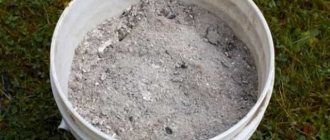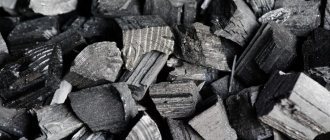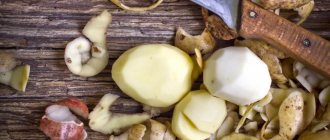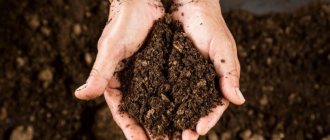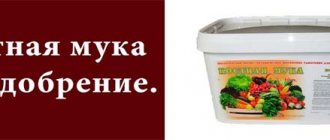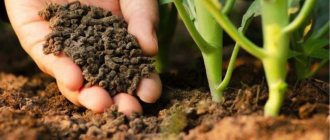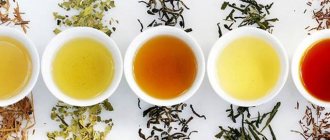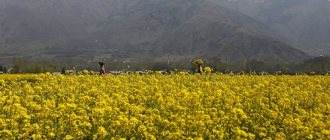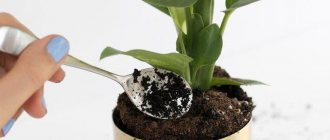It is perhaps difficult to imagine an even more affordable fertilizer for the garden and vegetable garden, like wood ash or soot. Often there is no question of where to get it. After all, after harvesting every autumn, dry tops and grass remain. They can be burned, and the resulting ashes can be applied locally throughout the garden.
Dear readers! For you, we have created communities on social networks in which useful articles and interesting ideas are published several times a day! Subscribe and receive useful content in a convenient format!
But there are definitely secrets to using wood ash as a fertilizer. After all, if you use it thoughtlessly, it can cause harm.
Therefore, this article will help you, in which you will find recipes for preparing fertilizers from ash, recommendations for its proper use, the most suitable crops for processing and much more useful for yourself.
Wood ash composition
Wood ash has been used as fertilizer for cultivated plants since ancient times. Its composition was quite accurately named by Dmitry Ivanovich Mendeleev.
Today, of course, the substance has been studied much more deeply. It consists of (per 100 g):
- Calcium carbonate – 17 mg;
- Calcium silicate – 17 mg;
- Sodium orthophosphate – 15 mg;
- Calcium sulfate – 14 mg;
- Potassium – 13 mg;
- Calcium chloride – 11 mg;
- Magnesium – up to 4 mg;
- Sodium chloride – up to 1 mg.
In total, there are about 30 microelements that are useful for most plants.
This is interesting. Wood ash in its pure form does not contain chlorine - another plus in favor of its use in the garden.
To put it simply, when choosing wood ash for your site, you can navigate like this:
- Deciduous trees have more calcium and various compounds in their ash.
- Coniferous trees are rich in phosphorus.
- Herbaceous plants, dried tops and other plant “garbage” are replete with potassium - combustion products in this case can contain up to 40% of compounds of this element.
For information. Young branches, straw, and various cereals are richest in micro- and macroelements. And much poorer: coal, peat.
What kind of ash is there?
Is it possible to use ash in the garden? Need to! But not every one.
For example, if you dispose of household waste, old boards with varnish and paint residues, or unnecessary printed materials (newspapers, posters, boxes, glossy magazines) with printing dyes and impregnations, the resulting ash is unlikely to benefit plants. Rather, the harm is due to chemical residues. This kind of ash should not be used.
But even when burning natural plant residues (branches, tops of plants, firewood, dry grass, peat), the output will be substances of different composition. Thus, wood ash contains a large amount of calcium - and there is much less of it in soft wood (aspen, spruce, pine, alder, linden) than in hard wood (oak, ash, elm, larch, poplar). And young wood contains noticeably more potassium compared to old wood. There is also a lot of this element in the ash obtained from the stems of sunflower and buckwheat, wheatgrass rhizomes, and grass.
The average percentage of compounds containing basic plant nutrition elements in the ash is given in the table:
| Ash | Potassium | Phosphorus | Calcium |
| Sunflower stems | 30-35 | 2-4 | 18-20 |
| Buckwheat straw | 25-35 | 2-4 | 16-19 |
| Rye straw | 10-14 | 4-6 | 8-10 |
| Wheat straw | 9-18 | 3-9 | 4-7 |
| Potato tops | more than 20 | up to 8 | up to 32 |
| Birch firewood | 10-12 | 4-6 | 35-40 |
| Spruce firewood | 3-4 | 2-3 | 23-26 |
| Pine firewood | 10-12 | 4-6 | 30-40 |
| Peat | 0,5-4,8 | 1,2-7 | 15-26 |
| Dung | 10-12 | 4-6 | 7-9 |
What ash cannot be used as fertilizer?
Without exception, any residues of organic origin will not harm cultivated plants. The main thing is not to overdo it with dosages (anything more than 30 kg per hundred square meters is considered a harmful dose).
Another thing is the product of burning household waste, plastic, plastic, etc. The ashes from them will naturally poison the soil and lead to the deposition of heavy metals and compounds in cultivated plants.
Also, this fertilizer is not recommended to be used simultaneously with other fertilizers: those based on nitrogen, potassium, phosphorus, and also with manure.
Feeding flowers with ash
Ash fertilizer is especially useful for roses, lilies, clematis, gladioli and peonies. When planting seedlings of flower crops, 5-10 g of ash are placed in each hole.
Flowers that have been attacked by pests are evenly dusted with an infusion of ash (with the addition of soap). Do this in the morning in calm weather due to dew or after rain. During drought, plants can be sprayed with water at room temperature before treatment.
Now you know how to prepare fertilizer from ash and how to use it correctly in the vegetable garden, garden and flower garden. This organic fertilizer is not only good for plants, but also safe for people and pets.
When can you feed plants with ash?
Crops growing in the garden can be fed with soot or ash throughout the warm season.
You can apply fertilizers in early spring by scattering them over the area and then digging up the area as standard.
Throughout the rest of the spring, as well as throughout the summer, you can add ash in a dry state or in solutions with water. Fruit trees and bushes are watered at the root. Flowering ones are sprayed completely. Vegetable crops are treated from above, the above-ground part, and watered in doses at the root.
During the growing season and fruiting, such fertilizer can be applied up to 4-5 times a year.
Wood ash will not harm at all when applied before winter. It is also scattered around the site before digging. And wintering plants, watered at the roots, will receive a supply of potassium and phosphorus, which will help them better withstand frost.
How to feed with ash
Ash is useful for almost all vegetable and fruit crops. It is irreplaceable on soils with an excess amount of clay, on acidic and hard soils.
This natural fertilizer retains its beneficial properties for up to 5 years.
Plants can be fertilized in different ways, the choice of which depends on the purpose of fertilizing:
- Feeding the roots.
It is an effective way of feeding.
The main thing is not to pour pure ash, be sure to mix it with soil and fertilizers. When planting new plants, it is enough to add about 15 grams to the holes. 2. Foliar fertilizer of plants
In turn, foliar feeding is divided into several subtypes:
- Sprinkling: it is enough to scatter the substance on the leaves and stems, which not only provides the supply of useful substances, but also repels pests. Ash can also be sprinkled on layers of compost to improve decomposition processes.
- Spraying: done with a solution or decoction. You can spray leaves, stems, tubers and seeds. The method is quite simple and effective.
- Fertilizing seedlings: just soak the seeds in an ash solution and add the ash to the hole before planting.
- Top dressing in the greenhouse: the first treatment is carried out before planting, the second – after the first leaves appear on the plant. The following fertilizing is carried out as necessary.
Types of fertilizing with ash
There are only two main ways to apply fertilizer from wood ash:
- in dry condition;
- in liquid mixtures.
Dry ash
It is easiest to bring in ashes in their normal state. The only difficulty that gardeners face is that in this case there may not be enough general supplies.
For reference. Wood ash stored in the open air and exposed to precipitation very quickly loses potassium from its composition.
Dry combustion products are simply poured under the roots of plants. It is only important to try to apply approximately equal dosages each time.
The procedure is best carried out before the next watering.
Tip: since it is not very convenient to scatter dry ash by hand, you can pour it into a nylon stocking and crush it over each plant being treated. And it will be economical, we will get rid of pests, and the crop will receive both foliar and root feeding.
In liquid mixtures
This method most of all allows you to use ash economically and evenly. But you will have to prepare the mixtures in advance. Although this is not at all difficult, it does take some time.
You can’t just pour ashes into water and add fertilizer like that. It is best to prepare an infusion.
The most popular and simplest recipe:
- A 10-liter bucket of ash should be poured into a 200-liter barrel. (Or less in appropriate proportions: 1 liter of ash per 20 liters of water).
- The barrel is left warm (in the sun) and the infusion is stirred every day. So 3 days.
- When the time has come, the infusion is again diluted with warm water in a 1:1 ratio and the plants are treated or watered.
Another method that allows you to release more micro- and macroelements into the fertilizer:
- You will need to pour boiling water over the ash. An iron bucket or pan is suitable as a container.
- For 10 liters of boiling water you need to use 2 cups of ash.
- Leave the mixture for a week, stirring every day.
Due to its rich composition of microelements, an infusion with boiling water is best used only as root nutrition for plants. It is not recommended to get into exposed areas of roots and plants.
Use of ash - when and how to use
How to use ash in the garden and garden? It is an excellent organo-mineral fertilizer, with which you can carry out both root and foliar feeding. When fertilizing plants with ash, you need to focus on the needs of your green pets.
It is added to excessively acidic soil for plowing, when planting tubers or seedlings, and when feeding adult plants. If this is root feeding, the application of ash must be combined with watering.
It is not recommended to mix ash with organic and ammonia fertilizers (to avoid ammonia losses), as well as with water-soluble phosphate fertilizers (ash reduces the absorption of phosphates by plants).
- in an infusion of ash (as a growth stimulant) before planting. 3 tbsp. ash is infused in 1 liter of water for a week, shaking occasionally to ensure uniform dissolution of the particles. The strained infusion is diluted with water 1:3 before use.
- A soap-ash solution (4 tablespoons of ash + 2 tablespoons of water, then add 1/3 of a piece of laundry soap dissolved in 2 liters of warm water) is sprayed on garden and garden plants to protect them from codling moths, sawflies, bud mites, onion and carrot flies, caterpillars.
- Ash powder is used to dust potato tubers before planting (1 kg per 30 kg of tubers) and sprinkle sections of fleshy rhizomes of flower plants when dividing them. Dry ash is scattered directly under the plants if they are overwhelmed by snails and slugs - invertebrates usually refuse to move on such a “carpet”. You can also dust plants damaged by white and gray rot and powdery mildew with ash as protection.
What plants love ash as fertilizer?
The vast majority of garden crops, fruit trees, shrubs and flowering plants will respond positively to fertilizing with wood ash. Exceptions are very rare.
Let's look at the key elements in wood ash and their impact on the main crops grown in the garden.
| Element | Main benefit | The greatest response to the introduction of an element |
| Calcium (and compounds) | It has a beneficial effect on the growth of green mass and improves metabolism between cells. Increases immunity and resistance to many common diseases. | cucumbers |
| Onion | ||
| Parsley | ||
| Strawberry | ||
| Apple tree | ||
| Grape | ||
| Rose | ||
| Potassium (and compounds) | Helps retain moisture, micro- and macroelements in tissues. An indispensable element that increases the frost resistance of plants | Lilies |
| Chrysanthemums | ||
| Roses | ||
| Grape | ||
| Phosphorus | A microelement that has a positive effect on the formation of the root system and root crops. | Tomatoes |
| cucumbers | ||
| Pumpkins | ||
| Magnesium | We promote enhanced starch formation. | Potato |
| Tomatoes |
By the way, wood ash is a natural potassium and phosphorus fertilizer. It can be used before winter to harden off wintering plants. A big plus is that it contains no nitrogen at all - this element is highly not recommended to be added before winter.
Properties of ash
With the help of wood ash in the form of fertilizer, gardeners enrich the soil with necessary components and regulate its Ph. These beneficial properties are enhanced by combining ash with peat, humus, and compost. The plants' need for a set of microelements is almost 100% satisfied due to the chemical composition of the ash. Each element formed in combustion products affects certain life processes occurring in plant tissues.
A high concentration of potassium in the ash allows increasing frost resistance in heat-loving crops. This is especially true when growing chrysanthemums, lilies, and roses.
Calcium derivatives have beneficial properties:
- Accelerate metabolism, thereby enhancing plant growth.
- Affect the absorption of nutrients.
- Activate photosynthesis processes.
- Affects the increase in green mass.
- Increases resistance to frost.
Magnesium compounds are a necessary trace element for the normal development of garden and vegetable crops. They affect cell metabolism. Thanks to this property, plant growth increases. In addition, magnesium is responsible for the sweet taste of vegetables and fruits.
Chlorides protect seedlings from fungal infections. They are able to extend the shelf life of harvested vegetables and fruits. In addition, they help to accumulate water in crops such as cucumbers and zucchini.
For which plants should ash not be used?
Yes, there are crops that are not recommended to be fed with wood ash under any circumstances.
- With such a “blow” of micro- and macroelements, which are found in abundance in wood ash, carrots grow clumsy, branched, and small. It is generally not recommended to feed carrots with anything after planting.
- All swamp berries, such as cranberries and blueberries, cannot tolerate ash fertilizing.
- Hydrangeas and rhododendrons should not be fertilized with ash, as they prefer acidic soils.
Nutrient composition
Depending on what parts of the plants wood ash was obtained as fertilizer from, the amount of nutrients differs. For example, you can get more potassium from dried leaves or grass. If wood serves as the raw material, then the plants and soil will receive more calcium and phosphorus.
Before using it in the garden, you need to figure out whether ash is what kind of fertilizer - nitrogen, phosphorus or potassium, in order to correctly correlate the data with the type of soil and not cause harm to the plants.
When burned, all volatile substances disappear into the atmosphere. First of all, it is nitrogen, so it is practically absent from the composition. Therefore, when using wood ash as a fertilizer, you will have to add additional nitrogen in the form of urea, saltpeter or complex fertilizers.
The chemical composition of wood ash as a fertilizer is not limited to macroelements and calcium. It contains almost the entire periodic table in microdoses. Plants need microelements such as those contained in wood ash that affect their appearance - magnesium, iron, and also improve metabolism - iodine, zinc and sulfur.
All of them are in compounds and become accessible to the root system after processing by soil microorganisms. The chemical composition of wood and leaf ash is different, but in any case it can be used, since the substance is food for bacteria. If there are enough of them in the soil, then other fertilizers will be completely absorbed.
Types of ash
Wood ash as a fertilizer and its beneficial properties can not only provide nutrition to plants, but also correct the acidity of the soil. The choice of raw materials influences the chemical composition. Of course, in a small summer cottage it is difficult to collect the required amount of ash so that it is enough for all the beds, but if there are fields or peat deposits nearby, then this can be used for your garden.
Peat is a rich source of calcium, so after burning it can deoxidize the soil. Podzolic soils or those that have been frequently fertilized with mineral fertilizers do not produce much yield due to the low pH level. To increase it, use lime, chalk or ash.
When burning pine needles, you can get ash as a fertilizer, which contains a large percentage of phosphorus. Phosphorus is also found in tree bark, wheat and rye straw. Regular leaves provide more potassium, which affects flowering and fruiting. Plants with tough stems - corn, sunflower - also provide more potassium in their residues.
How to use ash in the garden?
For any drug or fertilizer, it is important to know the normal dosage and method of application in order, firstly, to ensure maximum effectiveness, and secondly, not to harm beneficial plants.
Knowing this, remember that:
| Measuring containers | Quantity, gr. |
| Tablespoon | 6-7 |
| Cup | 100 gr. or 200 ml |
| Half liter jar | 250 |
| Liter jar | 500 |
| Bucket (10 l) | 5,000 (5 kg) |
In a free state, the ash is added, but they do it carefully, pointwise, not scattering it all over the garden, but sprinkling it near the roots (avoiding direct contact with them) and slightly capturing the surface of the leaves and stems.
In a dry state, it is more likely to be added to the soil when digging - this is more correct. Wherein:
- Add no more than 10 grams. (1.5 tablespoons) per hole when sowing;
- 150-200 gr. (about 1 cup) per square meter when digging in spring or autumn.
In other cases, the ash is most often diluted with water and the solution is poured over the bushes and the soil underneath them. The approximate consumption in this case is 0.5 liters per plant.
>Recipes for using ash solution
There are different concentrations of solution or infusion of ash for use in various situations: feeding vegetables, flowers, treating pests.
| Rules of application | |
| For seeds | It is useful to soak seeds collected with your own hands and unprocessed store-bought ones before sowing in an ash infusion to saturate them with microelements. 1 tbsp. A level spoonful of ash is stirred in a glass of warm water and left for a day. The seeds are placed in a gauze bag, which is lowered into a glass with infusion for 6 hours. There is no need to rinse the seeds in clean water before sowing. |
| For seedlings | It is useful to water seedlings of vegetable crops with ash infusion (1 glass per bucket of water), replacing them with mineral phosphorus-potassium fertilizer. Cabbage seedlings, thickly dusted with ash powder immediately after planting, will not become a victim of cruciferous flea beetle attack. |
| For strawberries | In the second year of life, it is useful to feed garden strawberry bushes with ash. It is not necessary to prepare a solution; just scatter the ashes around the bushes. Use 2 cups per 1 square meter. m of soil area. This feeding will be effective in the second half of summer. Dusting berries with fine ash helps protect strawberries from gray rot. |
| For roses | Using ash as a fertilizer helps roses:
Ash helps rose bushes not lack boron, an element important for the plant. When planting a rose bush in the spring, add about a glass of dry ash to the soil hole. For feeding, use a solution in a concentration of 1 glass per bucket of water, spending 0.5 liters per bush. Apply fertilizer in the second half of summer 2-3 times during the growing season. The same solution can be used as foliar feeding on rose foliage, using half as much ash. |
| For indoor flowers | When planting and replanting plants, add 1 tbsp for each liter of soil. spoon of ash. It is useful for geraniums, fuchsias, cyclamen and other plants that do not like acidic soils. As a phosphorus-potassium fertilizer, use an infusion of 1 liter of water and half a glass of ash. The solution is kept for up to 5 days in a dark place, then the flowers are watered with it. |
Top dressing from nettles and ash
Fresh nettle is often used to make “green manure”. This infusion of fresh nettle grass and other weeds (shepherd's purse, tansy) is prepared for 5-7 days, adding the Baikal preparation or a little yeast (fresh bread or crackers) to speed up fermentation.
To increase the effect of fertilizing, add ash to the container with grass, about 200 g per 15 liters.
Before use, the finished infusion is diluted 7 times with clean water. It is used to feed all vegetable crops, except garlic, onions, and legumes. When burning plant debris on the site, be sure to collect cooled ashes. It should be stored in paper bags in a dry place. Moistening the ash leads to a decrease in the concentration of potassium and other useful substances.
Using Ash in the Garden
Wood ash will definitely come in handy for caring for flower gardens or fruit trees.
By the way, with this choice, the plants are both fed and lightly, but protected from some pests.
Vineyards and rose bushes are most often fed with a solution of ash and water (infused for at least 72 hours). Apply by spraying, trying to completely treat the bush, leaves, flower buds, and soil around. During the season, up to 4-5 such feedings are performed.
Fruit trees and shrubs are fed a little differently. They do not need to add ash so often, but approximately once every 3-4 years. To do this, make a hole somewhere near the trunk. A solution of 40 liters of water and 2-3 kg of wood ash is poured into it. Afterwards the hole is filled with soil.
For shrubs, watering at the root with a solution of 0.5 kg of ash and 10-15 liters of water is sufficient.
Ash for the garden plot
The addition of ash is also beneficial for fruit trees and shrubs in the garden.
Fertilizing trees with ash is important when planting them (1-2 kg of ash in each planting hole), as well as later when digging up the soil under them using the same calculation.
the grapes with ash 3-4 times per season - in the evening after sunset, spray the leaves with ash infusion diluted with water in a ratio of 1:5.
The ash is also suitable for feeding strawberries (garden strawberries). In the fall, add 1 cup of wood ash per 1 square meter to the area prepared for it. m. In the spring, before mulching the soil and after fruiting, scatter a handful of ash between the rows before watering.
And before flowering, strawberries can be fed by dissolving 1 glass of sifted ash, 2 g of boric acid and 2 g of potassium permanganate in a bucket of hot water. Plants are sprayed with this composition during the period of inactive sun (morning or evening).
Using ash as a fungicide
This type of fertilizer has proven itself to be a simple natural remedy that repels many pests. But note that soot is a little more effective.
Ash is the white or gray, light ash after burning wood or dry plants. Soot is black, coarse combustion residue with grains of unburned material.
The most effective are infusions and decoctions based on combustion products. They treat all parts of the plant and the soil nearby.
Is it possible to fertilize citrus fruits with ash?
It is possible, and sometimes even necessary. Especially if the citrus plant grows in your orchard in an atypical climate. Ash will help him adapt better and increase his vitality.
Did you know? Estonia has begun to use granulated oil shale ash as fertilizer. The opportunity to granulate oil shale ash into fertilizer has been awaited for decades. A test batch of granules was produced in Germany, but by the end of 2021 it is planned to open a fertilizer plant in Ida-Virumaa in Estonia itself.
What pests can ash be used against?
Ash is used against almost any pest, since it is a mild agent that can harm the plant itself only in very high concentrations.
Can't stand the smell of wood ash:
- aphid;
- onion fly;
- carrot fly;
- cruciferous flea beetles;
- leaf beetles;
- caterpillars;
- weevils;
- codling moths;
- Colorado beetle;
- wireworms;
- nematodes.
And to be completely accurate, this list can include almost all insect pests.
Wood ash as a means of combating diseases and pests
Wood ash is used by gardeners not only as a fertilizer, but also as an effective folk remedy for protecting plants from various types of infections and harmful insects. It is used both in dry form and in liquid form: the powder is sprinkled on the above-ground parts of plants after rain, watering, or early in the morning on dew. To repel snails and slugs, ash powder is scattered under plants.
An ash solution for spraying plants is prepared as follows: 300 g of sifted ash is poured with boiling water and boiled for an hour and a half, then the broth is allowed to cool and settle, after which the liquid is drained without suspension, water is added to make 10 liters, and dissolved in the broth 40- 50 g liquid soap. It is best to treat plants by leaves with this composition in the evening, in dry weather.
The benefits and harms of ash for plants
Of course, wood ash is not a panacea for all ills in the garden. However, she does have a lot of positive qualities and very little negative influence.
So, you will see for yourself the obvious advantages:
- wood ash improves the quality of the crop because it enriches the mineral composition of the soil;
- the soil naturally deoxidizes;
- with its help it is possible to increase the rate of processing of organic matter in the soil;
- the composition contains about 30 useful microelements;
- no chlorine;
- microelements are easily absorbed by plants;
- at the same time it is possible to fight pests and some plant diseases;
- has a cumulative effect and increases soil composition for 3-4 years.
But be careful. Wood ash can harm:
- excessive doses lead to alkalization of soils;
- a negative effect has been observed not only on pests, but also on beneficial living organisms: for example, earthworms;
- if there is already a lot of potassium in the soil, then introduced wood ash can lead to the shedding of leaves and withering of plant flowers;
- an excess of calcium (found in ashes) can lead to a bitter taste in the fruit.
In addition, it is not recommended to use wood ash with other fertilizers. It is better to wait a few days after adding it to the soil or treating plants.
Wood ash - use in the garden, where it is possible and where it is not
Burnt wood can be successfully used in compost heaps to help create the best conditions for microorganisms to process organic matter. Sprinkle ashes over each layer of compost to enrich it with nutrients.
When used judiciously, it can be used to control various pests, such as slugs and snails, as it absorbs water from the organs of invertebrates. Sprinkle ashes around your plants to repel crawling pests. But as soon as the ash gets wet, it loses its restraining properties. Its continuous use for these purposes can significantly increase the pH of the soil, and this is harmful to plants.
Ash does not contain chlorine, so it can be applied to grapes, citrus fruits, strawberries, potatoes, raspberries, and currants. These crops do not tolerate chlorine. In addition, such fertilizer protects, for example, cabbage from clubroot diseases (a disease caused by a fungus that parasitizes the roots) and blackleg.
Do not apply wood ash around plants such as rhododendron and blueberries. They love acidic soil, and it reduces acidity, which will have a depressing effect on these plants
Potatoes respond well to its use when growing - the friability of potatoes increases by 1-1.5%, but still use it carefully when planting potatoes, as it contributes to the development of such a dangerous tuber disease as rhizoctonia or scab.
Do not use ash to fertilize seedlings until the third true leaf appears, as it contains too many salts that are harmful to immature plants. When planting seedlings of tomatoes, peppers, and eggplants, you can add 1 tablespoon of ash to the hole. But be sure to mix it with the soil, and also sprinkle soil on top so that the roots of the seedlings do not come into contact with it. Otherwise, they will get burned, the plant will hurt, and it will take a long time to take root in the new place.
Do not use wood ash to repel pests on radishes, radishes or turnips. You may scare off the pests, but you won’t get a harvest of radishes and the like - they will go to waste. That is, the root crops will stop growing, become coarser, become woody - they will release a flower arrow.
Dry wood ash does not lose its beneficial properties during storage for many years. But when soaked, it loses almost all the potassium. The percentage of potassium in the ashes depends on the type and age of the burned tree. The younger it is, the more potassium it contains.
Compared to potassium, ash contains little phosphorus. But such phosphorus is used by plants better than from superphosphate.
Common mistakes
- Not everyone clearly understands that wood ash is added in small portions.
- It is bad when ash is used together with nitrogen, potassium, and phosphorus fertilizers.
- This fertilizer is not added to indoor plants. Otherwise, you can ruin the soil.
- It is better not to use ash from paper products: magazines, newspapers, books to feed plants. The ink contains dangerous heavy compounds.
- The most dangerous consequence is overfeeding. Therefore, 4-5 fertilizing with this substance per year is enough.
- It is better to store ashes and soot in a closed container. In the open air, one of the main microelements, potassium, is rapidly washed out of them.
